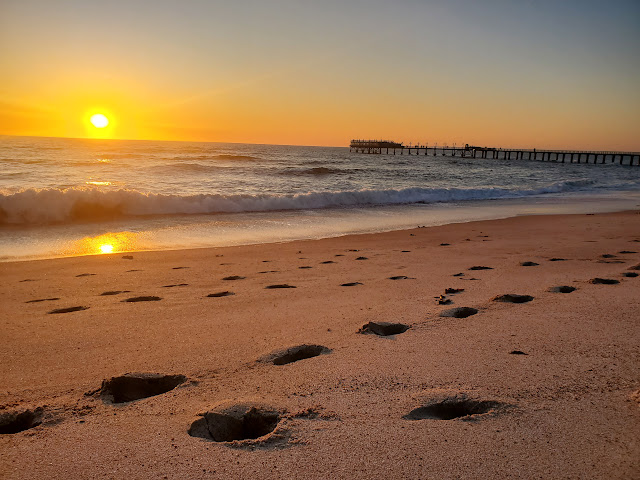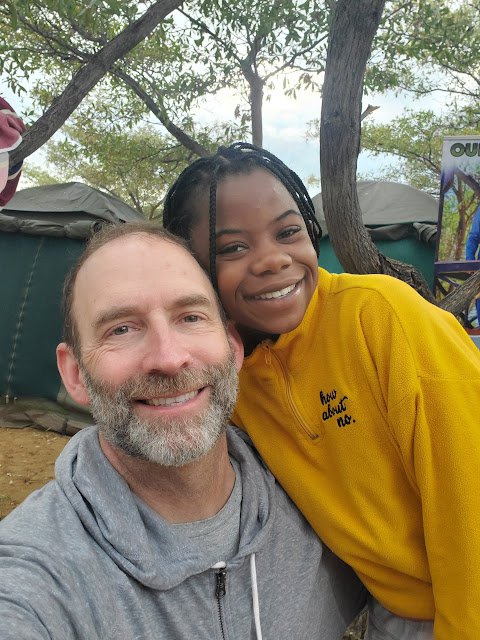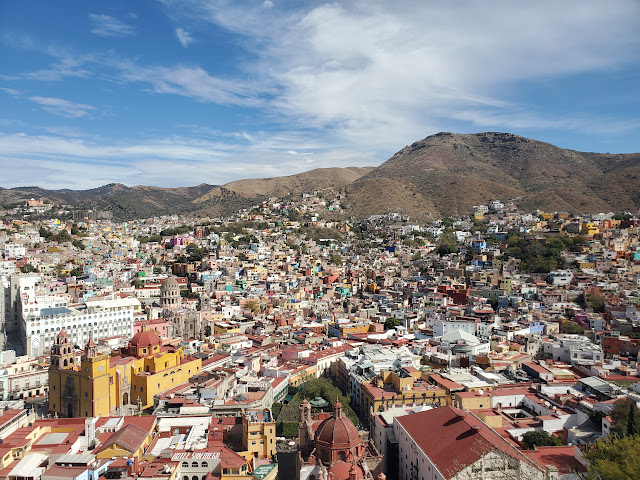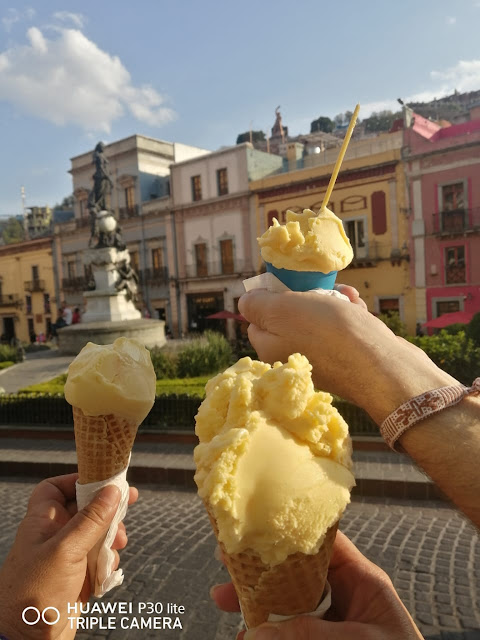Swakopmund, Northeast Namibia and Saturday at a Herero Wedding
My location has dramatically changed. I’m sipping a Hansa Draft while looking out at the Atlantic Ocean, on a small bay in the town of Swakopmund, Namibia. A group of a dozen dolphins just swam through the bay, playing alongside several human swimmers, jumping fully out of the water multiple times and causing the entire restaurant staff to stop working for a few minutes to take in the show. The sun is shining, my beer is cold, and life is good. It’s quiet here – as the season begins dipping into Autumn and with the busy Easter holiday week in the rear view. I arrived here around 11:00 this morning, having taken the Carlos Shuttle van service from Windhoek that was recommended to me by Elgin, a Namibian I sat with on my flight from Doha and who owns her own tour and guide service here in the country. She offered to provide me advice while I was here, and since this venture to Swakop is a solo excursion for me, I happily took her up on her offer. She recommended the shuttle service and also Hotel a la Mer where I’ll be spending the next three nights. The shuttle service picked me up directly from the hotel where Nathan, Brett and I spent last night – a convenience, definitely – but that also meant meandering around Windhoek for about an hour, picking up the other dozen or so people who packed inside the van with me. I was the first stop. My first seat mate, an older white woman, immediately began peppering me with questions and sharing stories of her adventures in Namibia. When I had my chance, and while there were still a few empty seats, I politely got up and moved further toward the back. I felt a little bad, but when I saw that during the 4-hour trip she never stopped yammering on to the young man (victim) next to her, I was happy I’d made the choice I had.
As I said, Nathan, Brett and I spent the night last night in Windhoek, in the Kubata City Hotel – a cute, homey place with a Portuguese vibe, an interior green courtyard, a small pool, plenty of deck chairs, and a large enclosure containing multiple varieties of birds. We arrived there after several long days on the road, culminating in a visit to the village of Iseki and a family Brett became very close with during his Peace Corps days in the Zambezi region of far northeast Namibia. It was a lot of driving, but the rewards were many.
I accompanied Brett for the day on his visit to his former village, where I met Annette, a woman and matriarch of the family who Brett taught with 30 years ago in the village. Together we mourned her husband, Ignatius, another fellow teacher and close friend, drinking buddy and hunting partner of Brett’s who passed away from Covid-19 just a short time ago. The visit included long conversations with Annette and two of her adult children, Chuma and Simwanza, under a large shade tree, a visit to the father’s grave where I witnessed Brett’s tears and the unmistakable emotions on his face of love, grief and longing for joyful days gone by, and a traditional lunch that involved the family remaining outdoors while Brett and I dined together, just the two of us at the kitchen table. After this memorable day, and after saying our thanks and goodbyes to the family, Brett took me to an old watering hole (human drinking spot) outside the village – a small shack with a bar, pool table and TV - where we joined locals for a cold beer and a few minutes of Premiere League soccer. The 2-day drive was worth this day alone.
Our journey north also included two relaxing, easy-going nights at the Caprivi River Lodge, just outside of Katima Mulilo, along the Zambezi River that separates Namibia from Zambia to the north. The river is known for its hippos, crocodiles, and snakes. However, due to the high-water levels – we were told – hippos hadn’t been spotted lately, and alas, we saw none. Nor did we see any crocs. But, while having some drinks on a deck above the water, we did witness a long black snake swim along the surface of the river, past us, then disappear into some trees. On those nights we had fixed menu dinners, the first of which included a main course of bream (fish from the Zambezi) and the second a tender, breaded pork chop with tradition pap, a porridge made from cornmeal. These were evenings well-spent, that gave Nathan, Brett and I a real chance to relax after the wedding and to reflect on our Namibian experience thus far.
OK, now that I've wrapped up the past few days, we must return to the wedding. I fear I’ll complete my trip, get on the airplane and still not have finished chronicling every highlight of those three celebratory days. So, back to it.
Saturday at the wedding, at Emily's family farm. The longest, busiest day of the festivities. I awoke, well-rested, having survived a less-than-ideally-comfortable cot, Brett’s snoring and a bladder that continued to fill but one I refused to empty during the night. You know, snakes and scorpions and other potential creatures of the night and all. The morning commenced with breakfast. Scrambled eggs with veggies, sausages, cheese and bread, all cooked on the open fire by Lady and Lucy. Of course complete with some 3-in-one (coffee, cream and sugar) instant coffee. Brett and I were seated at a special table, again reserved for the most special of guests. This royal treatment was nice, but slightly uncomfortable at times as well. After breakfast we were invited to take bucket baths – baths of hot water in a small basin and soap – then we once again got dressed in our formal clothes for the remainder of the day. Partaking in these rituals, watching the camp come alive, and greeting people I’d met the previous day, now in the brightness of morning, was special. I was already feeling at home, and I was enthusiastic and excited about the day ahead.
After more time seated next to Nathan’s tent, talking, and greeting guests, first on the agenda of today’s events was another slaughter – this time the important slaughter of a cattle, the meat of which would have multiple meanings on this day. Again, I watched it. Again, I took pictures and video. It was a bit brutal, I’m not going to lie, but again, who am I to judge? I have no qualms about eating a juicy burger or thick steak back home. Why should I be troubled by something here, in this culture, that happens every day in my culture as well?
Several men broke down the meat of the cattle, a large section of ribs was separated and hung to dry for later, and a meal was prepared. The meat this weekend was rarely, if ever, cooked directly over the open flame in grill form. It was always cooked in a large pot, often with vegetables and always in a stew of some kind. To a Westerner’s palate, it was presented much differently that how we’d normally eat a beef stew back home. In your bowl came meat, but always on the bone, always a bit of process to separate the meat from that bone, done with one’s fingers in what ended up a big, sloppy, delicious mess.
The day then became a mix of long periods of relaxing, sitting in our camp, and greeting more guests peppered with short moments of ritual and ceremony. I snuck in a couple of naps in my tent during the day, when there were breaks in the action, to get a respite from the somewhat exhausting process of meeting and chatting with many, many new people. Don’t get me wrong, the people were amazing, and it felt terrific to be an honored guest and just sit back while people paraded into camp, wanting to extend their welcome and chat a bit with the groom-to-be and his party from America. Another important event on this day was the arrival of Chad and Claire. Chad is an old family friend, a close friend of Nathan’s and a neighbor we grew up with a few blocks away from our Princeton home. Chad couldn’t miss the wedding, and he also wanted his teenage daughter Claire to be part of this once in a lifetime event. They had flown in the day before, but had arrived in the evening, and since driving in rural Namibia in the dark is not for the faint of heart, they had decided to stay in Windhoek and drive to the farm on this morning. It was great to see the two of them, and they settled in right away – Chad taking a spot alongside us to be introduced to other guests and Claire being swept up by a half-dozen young girls whose fascination with her long, blonde hair was quickly evident. Combing and braiding commenced almost immediately.
Regarding the events of the day, presentation and consumption of meat again took center stage. The rack of ribs I mentioned earlier that had been hung out to dry after the cattle slaughter this morning became part of an event in which our side and Emily’s side exchanged ribs. Emily’s people arrived first, to present their rack. We stood, gathered together and gratefully accepted this gift. Then later, our contingent took our rack, and walked solemnly together to Emily’s side and presented them with ours. They, as well, greeted us and honored the gift of meat. Later, the best piece of rib meat, cooked by Emily’s side, was then brought to us and presented to Nathan in a pot, as he sat just inside his tent. Like every event, this came with fanfare, lots of onlookers and many pictures. After Nathan ate a portion of the rib, the rest was then carried back to Emily’s side where Emily consumed the remainder. I was told that this ritual honors the Old Testament story in which God creates Eve by removing a rib from Adam’s chest. The creation of woman from man.
Later that day, there was more singing, similar to what we had enjoyed the night before, then after that another ceremony. In Otjiherero it is called “Orunde.” With guests watching on from the yard in front of the farmhouses – married guests up front and unmarried guests in the back – Emily was escorted outside, surrounded by her 20 or so bridesmaids. They gathered close, protecting Emily and keeping her mostly unseen from the rest of us. She also had a very large veil that covered her entire face. Two things define the Orunde ritual. One is the presentation and eating of meat from the part of the cattle’s spine where the neck meets the back. This symbolizes the joining together of the two families and also the recognition that marriage is sometimes difficult. Just like climbing a mountain, I was told, Hereros recognize that marriage can often be a challenge. When one experiences rough times on the journey up a mountain, one puts one’s hands to one’s back, feeling relief and strength to continue. The meat from the neck area of the cattle symbolizes the need to sometimes bend, and lean, and look for inner strength during a marriage. The second ritual of Orunde involves tendons from the back of the cattle and fat from around the cattle’s stomach. Earlier in the day, the tendons were given to Emily’s mother, and during Orunde she donned the tendons around her head. The fat was given to Emily and her bridesmaids, and was placed onto their hats by Emily’s father to symbolize luck and good fortune. During Orunde Emily’s father’s sister ceremoniously removed this fat from their hats.
Then it was time to meet Emily. Remember, during the entire week and weekend Emily had been required to remain indoors, flanked by attendants and only able to watch various events looking out from a small window. Our group, Chad, Brett and I (but not Nathan), were escorted into the small house. We bowed our heads and then took a seat on the floor with Emily. It was nearing sunset, so the room was quite dark as we spoke some words with Emily and took in the beautiful bride in her beautiful white dress. The moment was brief, we said our goodbyes and good lucks, then were escorted back out into the waning light of early evening.
I should also mention that this day was the day in which family, friends and revelers got dressed in their most formal, most traditional clothing. The photo opportunities were endless, with guys spiffed up in full suits and hats, and ladies clothed from head to toe in a traditional dress, in a variety of amazing patterns and bright colors that spanned every color of the rainbow.
Then the party commenced. With all the ceremony and ritual of the day behind us, it was time to have some fun. Beers and brandy drinks flowed. Campfires roared. Music pumped, and guests moved from one camp to another, taking in various unique scenes in various locations around the farm. It was a blast, and I was ready. After my two naps and after the formality of the day, it was great fun to let loose a little, get a little “tipsy” as the people say here, dance a little, talk a lot and enjoy the beautiful Namibian night well into the wee hours of the morning. Saturday was a big day – a very fun day – and only the ceremony of Sunday morning remained. I went to bed a happy, somewhat drunk, man, and slept like a baby.
As I’m nearing the end of the trip, I’m guessing Part 4 of the wedding festivities will be my last post, and probably a post I’ll write either mid-flight or from an airport somewhere along my journey home, a journey that begins on Tuesday. I’ll have 36 hours, so that should give me plenty of time to sum up the wedding and the last remaining adventures I’ve enjoyed during the tail end of my trip. I’ll see you back here in a few days!

























Comments
Post a Comment